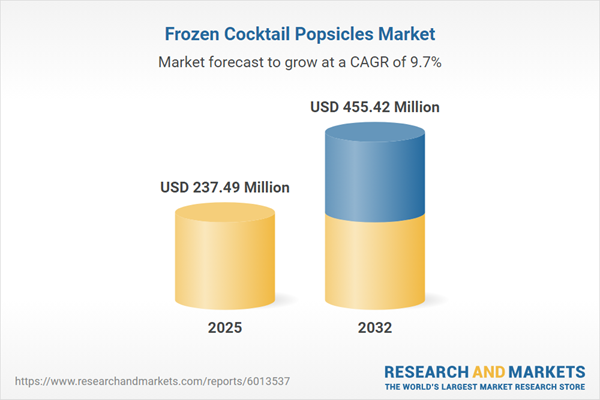Speak directly to the analyst to clarify any post sales queries you may have.
The frozen cocktail popsicles market is rapidly evolving as innovative consumer preferences and supply chain advancements create new opportunities for differentiation and growth. Senior decision-makers seeking to capitalize on this category will find actionable insights in this comprehensive analysis of market drivers, evolving regulations, and competitive trends.
Market Snapshot: Frozen Cocktail Popsicles Market Growth
The Frozen Cocktail Popsicles Market grew from USD 217.78 million in 2024 to USD 237.49 million in 2025. It is expected to expand at a CAGR of 9.66% and reach USD 455.42 million by 2032.
Scope & Segmentation
This report provides deep-dive analysis and revenue forecasts across the full frozen cocktail popsicle value chain. Segmentation addresses changing consumer tastes, production innovation, and emerging sales patterns across global regions. Key coverage areas include:
- Flavor Types: Classic cocktails such as margarita, mojito, piña colada; Fruit-based profiles including berry, citrus, and tropical.
- Consumer Age Groups: Below 25 years, 25–35 years, 35–50 years, and above 50 years, each with distinctive purchasing behavior and taste priorities.
- Packaging Types: Multipacks suited for social settings and single-serve formats for on-the-go or impulse occasions.
- Alcohol Content: High-alcohol as party options and low-alcohol formulas for wellness-oriented, daytime, or health-conscious consumption.
- Sales Channels: On-trade venues (bars, clubs, restaurants), online platforms (brand websites, e-commerce), and retail (convenience stores, liquor stores, supermarkets).
- Regional Markets: Americas (including the United States, Canada, Mexico, Brazil, Argentina, and others), Europe, Middle East & Africa (focusing on Western Europe, the Gulf states, and emerging African urban centers), and Asia-Pacific (spotlighting East and Southeast Asia, the Pacific, and tourism-driven hubs).
- Leading Companies: Profiles and recent activities of firms such as 24 ICE B.V., American Beverage Corporation, Claffey's Frozen Cocktails, Cooloo, Cutwater Spirits Anheuser-Busch, FrutaPOP, J&J Snack Foods Corp, Karamu Ltd, LIC Frozen Cocktails, SHOOTER POPS, LLC, Slim Chillers Corporation, SMART ICE TRADING B.V., SnöBar, The Absolut Company, Wavey Ice, and Harvest Hill Beverage Company.
Key Takeaways for Decision-Makers
- Artisan mixology techniques have transitioned into convenient, freeze-and-enjoy formats, satisfying demand for complex flavor experiences and mobile indulgence.
- Premiumization trends are driving focus on locally sourced ingredients, small-batch recipes, and sustainable packaging to enhance brand value and product appeal.
- Collaborative strategies between established dessert brands and craft distilleries are fostering rapid flavor portfolio diversification and expanding distribution reach.
- Emergence of direct-to-consumer and digital sales channels encourages fast feedback cycles, community engagement, and innovation in limited-edition offerings.
- Distinct age demographics, packaging types, and alcohol content options sharpen segmentation, enabling tailored approaches for specific consumer segments and occasions.
- Regional variations in ingredients, regulatory requirements, and flavor trends are shaping market entry strategies and operational models, minimizing risk and maximizing growth potential.
Tariff Impact and Adaptive Strategies
Recent US tariffs on imported spirits and specialized packaging are shifting sourcing and production towards domestic partners and alternative alcohol bases. Producers are building resilience by partnering with local distilleries and growers, optimizing production footprints, and innovating in ingredient and packaging selection to control costs and maintain market agility.
Methodology & Data Sources
This report integrates primary interviews with industry leaders, secondary research from reputable trade and academic sources, and expert panel reviews. Data triangulation ensures reliable, holistic analysis across consumer, regulatory, and technological dimensions critical to the frozen cocktail popsicles market.
Why This Report Matters
- Enables strategic planning and investment decisions by segmenting the market for maximum relevance and growth potential.
- Assesses regulatory, technological, and supply chain shifts, equipping business leaders to anticipate change and sustain competitiveness.
- Supports data-driven entry or expansion strategies by detailing emerging regional and consumer trends across global markets.
Conclusion
The frozen cocktail popsicles market presents actionable prospects for senior stakeholders seeking growth through agile innovation, robust partnerships, and tailored consumer engagement. This analysis delivers the strategic clarity needed to succeed in a dynamic, fast-growing segment.
Additional Product Information:
- Purchase of this report includes 1 year online access with quarterly updates.
- This report can be updated on request. Please contact our Customer Experience team using the Ask a Question widget on our website.
Table of Contents
3. Executive Summary
4. Market Overview
7. Cumulative Impact of Artificial Intelligence 2025
Companies Mentioned
The companies profiled in this Frozen Cocktail Popsicles market report include:- 24 ICE B.V.
- American Beverage Corporation
- Claffey’s Frozen Cocktails
- Cooloo
- Cutwater Spirits Anheuser-Busch
- FrutaPOP
- Harvest Hill Beverage Company
- J&J Snack Foods Corp
- Karamu Ltd
- LIC Frozen Cocktails
- SHOOTER POPS, LLC
- Slim Chillers Corporation
- SMART ICE TRADING B.V.
- SnöBar
- The Absolut Company
- Wavey Ice
Table Information
| Report Attribute | Details |
|---|---|
| No. of Pages | 180 |
| Published | November 2025 |
| Forecast Period | 2025 - 2032 |
| Estimated Market Value ( USD | $ 237.49 Million |
| Forecasted Market Value ( USD | $ 455.42 Million |
| Compound Annual Growth Rate | 9.6% |
| Regions Covered | Global |
| No. of Companies Mentioned | 17 |









